Z
Zach Weiss
Guest
Feed from Wornandwound.com .Borealis Watch Forum takes no responsibility for any of the content posted.
Value plays a huge role in the watches we discuss on worn&wound. It’s a subjective quality for sure, but one that we keep in focus, if for different reasons. Perhaps the clearest and most obvious is simply the relationship of cost to components offered. The more cost stays down as component quality or perceived price goes up, so does the value. Which is to say, a brand is paying more, but making less per watch. This isn’t a hard fast rule, and it can make for tricky arguments such as “well if brand A charges X, then why does brand B charge Y for the same thing”, but when that relationship is clearly working in your, the customer’s, favor, it’s hard to deny the appeal.
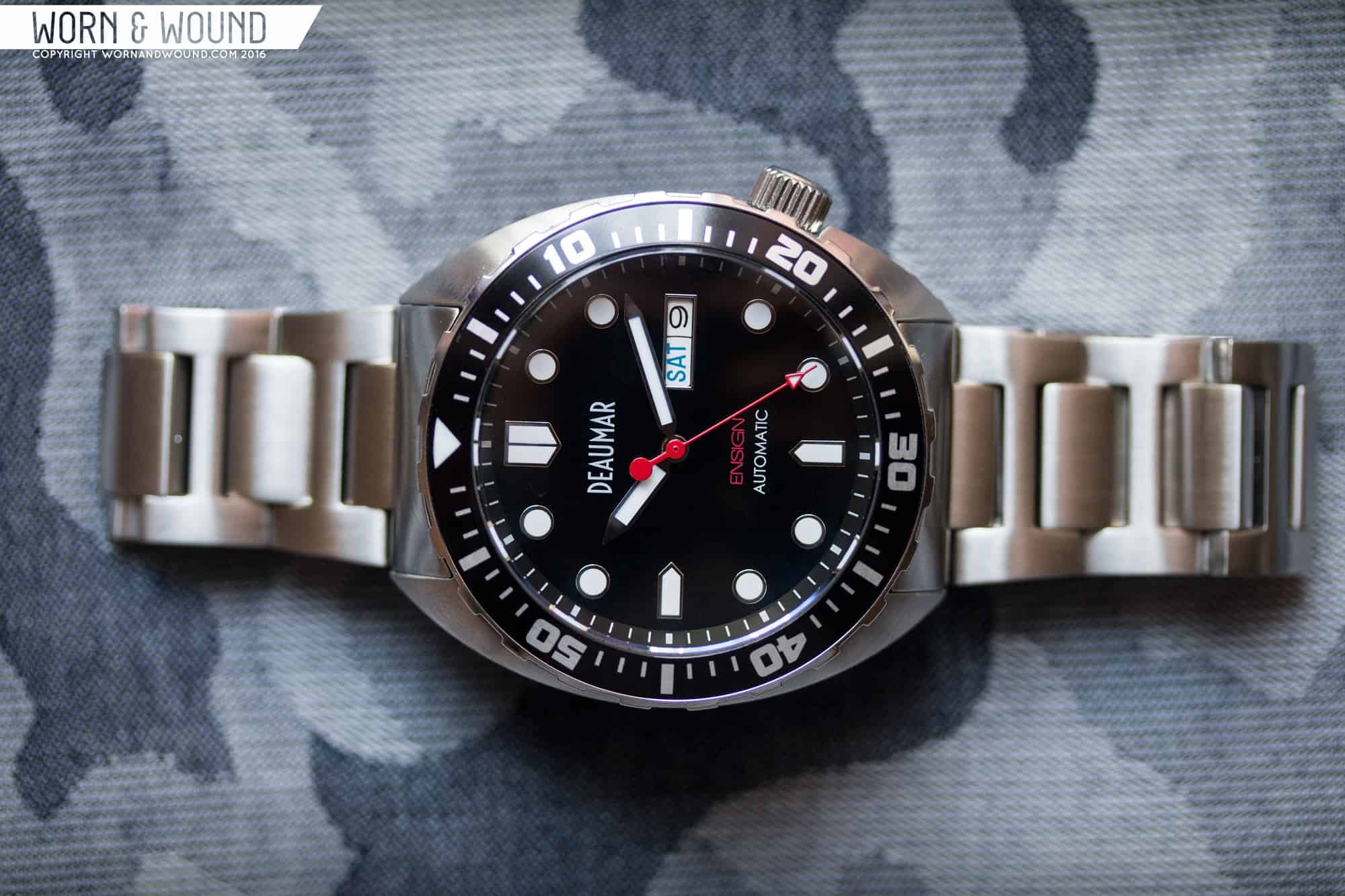
Enter Deaumar, a new brand from Great Britain. Pronounced dough-mar, their first watch, the Ensign, is a value driven offering. A 200m sports/dive watch with straightforward looks, sapphire crystal, ceramic bezel, bracelet with solid end links that is powered by a Seiko NH36 automatic movement. Solid components that I would expect to be in a watch starting around $500, but the Ensign comes in well under that. Currently being presold for £169, then increasing to £199 regular (both without VAT), or about $244/$286, the Ensign offers a lot per dollar. Of course, none of that matters if the watch itself isn’t well made and enjoyable, so let’s take a closer look.
$250
Deaumar Ensign Prototype Hands-On
Case
Stainless Steel
Movement
Seiko NH36
Dial
Black
Lume
C1 SuperLuminova
Lens
Domed Sapphire
Strap
Bracelet
Water Resistance
200m
Dimensions
42 x 47mm
Thickness
14.3mm
Lug Width
22mm
Crown
6.5 x 4mm screwdown
Warranty
1 Year
Price
$250
Case
The Ensign features a lugged barrel case design, giving it a clean and slightly retro look. Measuring 42 x 47 x 14.3mm (to the top of the domed sapphire crystal), the watch is a chunky medium. The width makes it modern, but not too large, while the short lug-to-lug keeps it wearable. The design is very simple, the mid case curves around in true barrel fashion, with a domed top surface and slab sides, which are filled out by the end links, creating an overall solid looking watch. Adding some refinement, the top surface is lightly brushed while the sides are left polished. The sides are fairly tall, creating a large polished area, which looks nice out of the box, but I wonder if after some wear and tear and a few inevitable scratches and dings, how it will look.
Most of the top of the watch is dominated by the bezel, which features large gear-like teeth for grip. On the production models, the insert will be ceramic, which is a great addition on a watch at this price point. That will change the look a bit from what is seen here, likely for the better, and certainly adds to the durability of the watch as ceramic is hard to scratch. The bezel features a 120-click uni-directional mechanism with a solid and precise click.
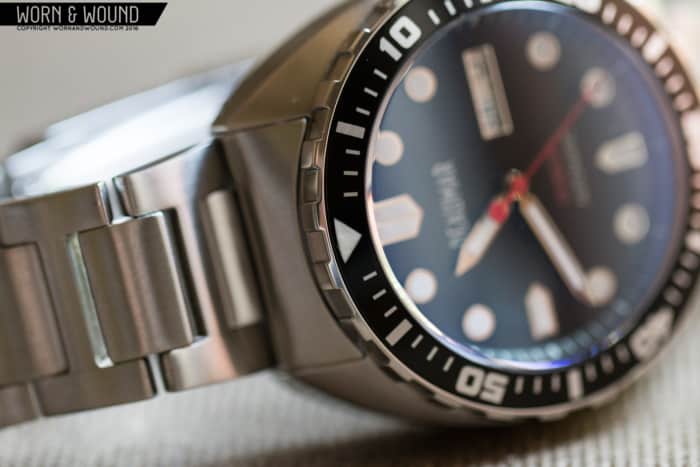
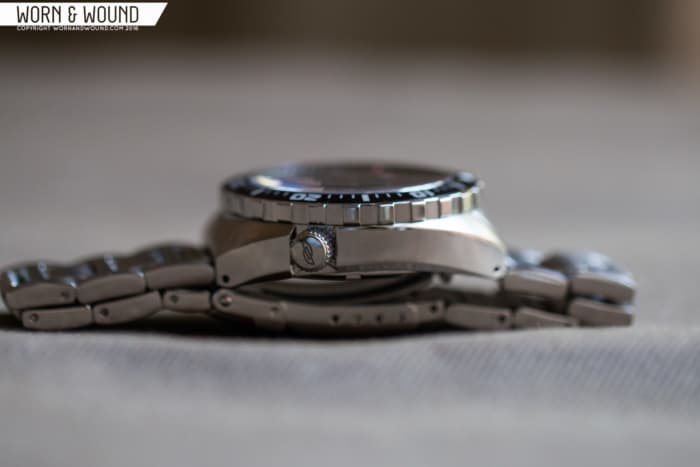
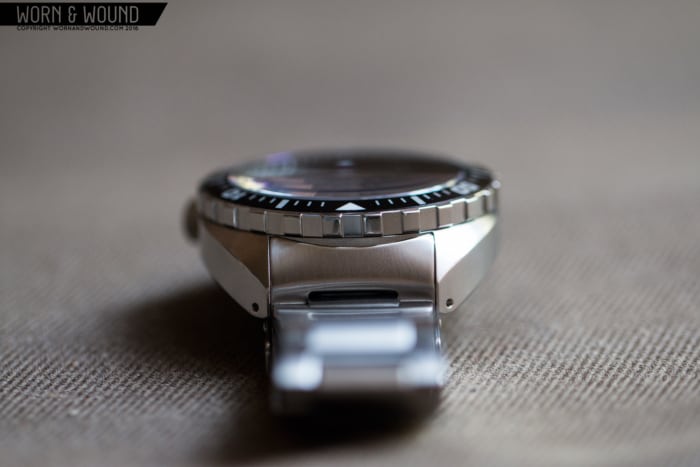

Just off of four is a screw-down crown that measures 6.5 x 4mm. It has coining along its edge for grip, and an interlocking-D logo etched into its flat side. Positioning the crown off of four prevents the crown from digging in at all, protects it a bit and generally makes the watch look a bit less wide. Flipping the ensign over, you have a solid case back with basic info etched in and a logo in the center. Pretty simple and straightforward, which is definitely the theme of this time piece.
At this price, the most important factor is really build quality, as one must wonder how they are achieving such a low price point. While I didn’t take it 200M down, in all other ways, the Ensign seems to be well built. Bezels, for example, can often feel cheap (even on expensive watches), but this one is solid and precise.
Dial
The dial of the Ensign is reduced to only the necessary elements for a dive watch. The main surface of the prototype sent to us is gloss black with a primary index of applied markers with polished steel surrounds and lume filling. At 12, 6 and 9 the markers are straight sword shaped, doubling at 12. The rest of the markers are circles and at three is a wide day/date window. The marker set is clear, legible and well proportioned, albeit very standard. The use of a gloss black gives the dial some unexpected depth, making the markers almost appear as though they are floating, which is appealing, but it comes at the cost of casting some distracting reflections.
Around the main surface is a steeply angled chapter ring with a minute/second index of white lines that get thicker at intervals of 5. Simple and sporty, this adds some visual complexity to the dial, which might have been too plain with just the applied markers. Back to the main surface, at 12 you have a large “Deaumar” text logo below 12 in white, in a tall, thin typeface. Above 6, Ensign” and “Automatic” are printed in red and white respectively. The use of red is a nice touch, and obviously hints at some historical dive watches.
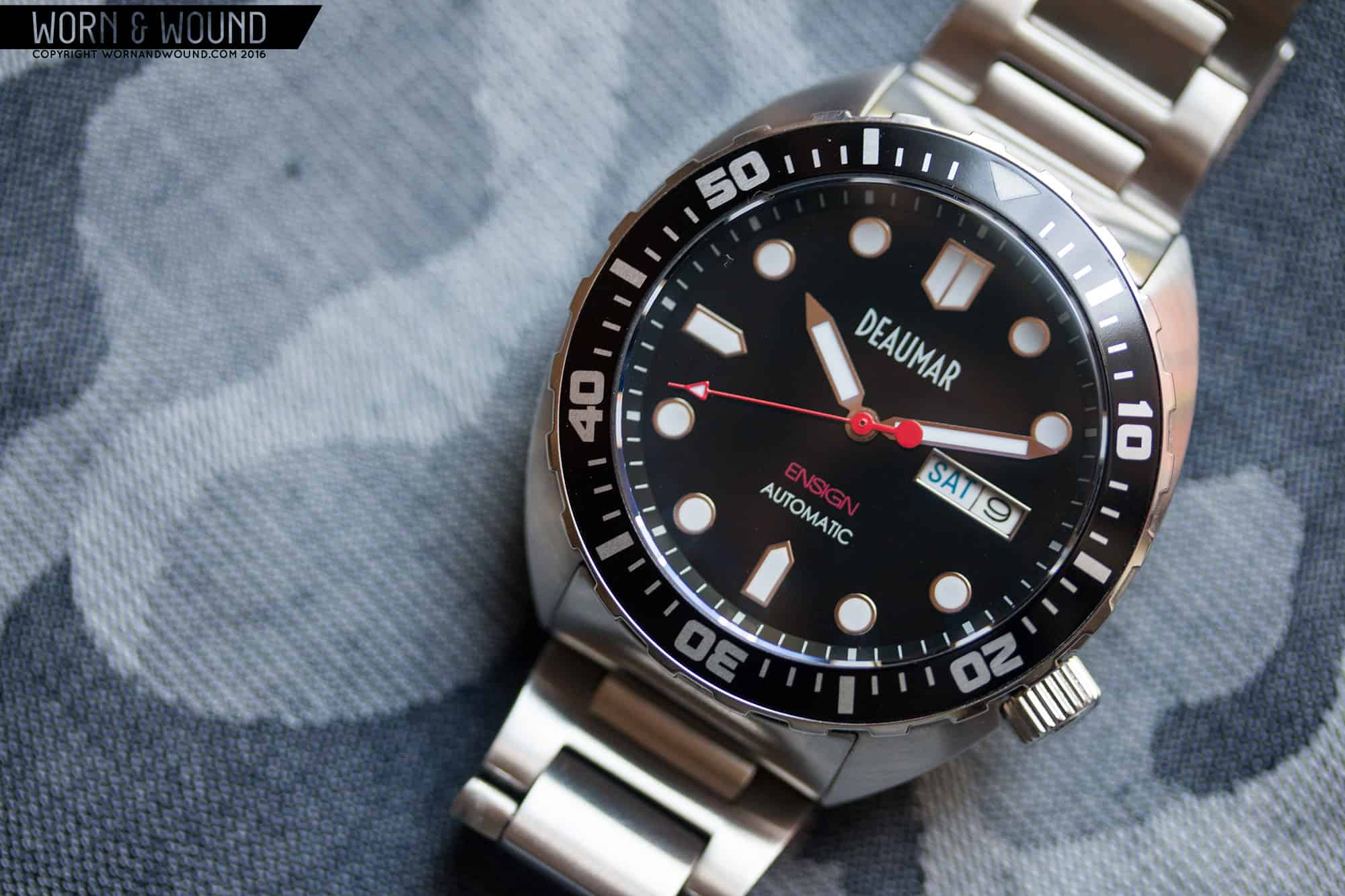
The bezel insert adds the most complexity to the overall look, with a full index consisting of lines per minute, and heavy lines and numerals alternating every 10 units. The typeface for the numerals is bold and chunky, standing out very clearly. Once again, the sample is different from production, as here they are negatives in the black, showing the steel below. On the final, they will be painted into the ceramic. Because there are no numerals on the dial itself, the bezel becomes a useful reference when set to its home position.
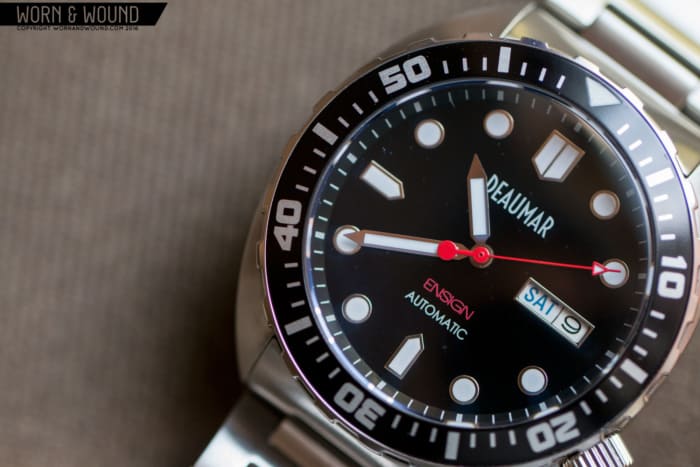



For hands, the Ensign went with a slightly surprising choice. Rather than more typical dive watch styles, they went with polished pointed swords that taper as they connect to the central axis. I associate hands like this more with field watches than dive watches, but they don’t look out of place on the Ensign either. The only gripe I have is that the hour and minutes are a bit similar in length and width at a glance. The second hand is then a dark red stick with a triangular tip and a solid, circular counter-weight. The pop of color is nice, disrupting the overall conservative design just a bit. Perhaps in plo-prof style, the minute hand could have been red while the seconds was steel, as the former is more functionally important.
The Ensign will feature C1 lume on the applied markers, hands and in the triangle on the bezel. It’s also available with blue, red, orange or white dials giving you some options to customize it to your taste.
Bracelet and Wearability
The Ensign comes on a steel H-link bracelet. I was immediately pleased to see something different than the standard oyster style, and the H-link looks very nice. It’s 22mm at the lugs and features solid end links (the prototypes are hollow, but the production will be SELs), but tapers to about 20mm. Instead of a gradual taper over a few links, the very first link after the end-link goes from 22 to 20, which actually does a great job of continuing the flow of the case into the bracelet. To make strap changing easier, the Ensign features drilled lugs, which is something I personally love.
Perhaps the best thing about the Ensign is how it wears. 42 x 47mm makes for a comfortable sport watch with some presence. Though I might lean towards smaller watches, this isn’t too big for my 7” wrist, and is actually a great size for something a bit larger and chunkier. The 14.3 height isn’t too bad either, especially since this is a dive watch of sorts, so it’s expected.

Despite being a bit generic, the Ensign looks good. It’s purposeful, well proportioned and features attractive elements. It doesn’t jump out or draw attention, but it doesn’t look meek or shy either. It’s safe, but compared to a lot of modern watches that air on trying to be cool, I’d prefer plain and not tacky to the alternative. As with most sports watches, especially ones with colored dials, the Ensign is best suited to casual attire.
Conclusion
Maybe it’s because our five year anniversary just passed, but the Deaumar Ensign makes me a bit nostalgic. It reminds of the watches that we sought out and covered when we first started w&w. Watches that were purpose and value driven over anything else. The industry has changed a lot since then, with more and more brands vying for attention, the bar continually being raised. And we’ve changed too. After seeing hundreds to thousands of watches, our interests have turned to more complex and nuanced pieces. So seeing something like the Ensign, a watch that is very matter of fact with a handsome, but unadventurous design, good components and a great price tag, it’s refreshing and reminds me of the days when I just wanted a good watch.
And that’s what it is, a good watch. No frills, no bells and whistles, just a solid watch that tells the time, is meant to be worn, used and beat up (within reason). For £169 pre-order, £199 regular, or about $244/$286 + shipping, the Deaumar is undoubtedly a good value for a 200m sports watch with a ceramic bezel, sapphire crystal, Seiko NH36 automatic and a bracelet. This price point puts it up against a few affordable classics, namely the Orient Mako and Seiko SKX007, but by having ceramic, the Ensign offers some additional value in its components. If nothing else, it’s a nice alternative to those watches should their aesthetics not interest you. The Ensign is currently in production and expected to ship Aug 2016.
Images from this post:
The post Deaumar Ensign Prototype Hands-On appeared first on worn&wound.
Continue reading...
Let us know your thoughts and impressions.
Value plays a huge role in the watches we discuss on worn&wound. It’s a subjective quality for sure, but one that we keep in focus, if for different reasons. Perhaps the clearest and most obvious is simply the relationship of cost to components offered. The more cost stays down as component quality or perceived price goes up, so does the value. Which is to say, a brand is paying more, but making less per watch. This isn’t a hard fast rule, and it can make for tricky arguments such as “well if brand A charges X, then why does brand B charge Y for the same thing”, but when that relationship is clearly working in your, the customer’s, favor, it’s hard to deny the appeal.

Enter Deaumar, a new brand from Great Britain. Pronounced dough-mar, their first watch, the Ensign, is a value driven offering. A 200m sports/dive watch with straightforward looks, sapphire crystal, ceramic bezel, bracelet with solid end links that is powered by a Seiko NH36 automatic movement. Solid components that I would expect to be in a watch starting around $500, but the Ensign comes in well under that. Currently being presold for £169, then increasing to £199 regular (both without VAT), or about $244/$286, the Ensign offers a lot per dollar. Of course, none of that matters if the watch itself isn’t well made and enjoyable, so let’s take a closer look.
$250
Deaumar Ensign Prototype Hands-On
Case
Stainless Steel
Movement
Seiko NH36
Dial
Black
Lume
C1 SuperLuminova
Lens
Domed Sapphire
Strap
Bracelet
Water Resistance
200m
Dimensions
42 x 47mm
Thickness
14.3mm
Lug Width
22mm
Crown
6.5 x 4mm screwdown
Warranty
1 Year
Price
$250
Case
The Ensign features a lugged barrel case design, giving it a clean and slightly retro look. Measuring 42 x 47 x 14.3mm (to the top of the domed sapphire crystal), the watch is a chunky medium. The width makes it modern, but not too large, while the short lug-to-lug keeps it wearable. The design is very simple, the mid case curves around in true barrel fashion, with a domed top surface and slab sides, which are filled out by the end links, creating an overall solid looking watch. Adding some refinement, the top surface is lightly brushed while the sides are left polished. The sides are fairly tall, creating a large polished area, which looks nice out of the box, but I wonder if after some wear and tear and a few inevitable scratches and dings, how it will look.
Most of the top of the watch is dominated by the bezel, which features large gear-like teeth for grip. On the production models, the insert will be ceramic, which is a great addition on a watch at this price point. That will change the look a bit from what is seen here, likely for the better, and certainly adds to the durability of the watch as ceramic is hard to scratch. The bezel features a 120-click uni-directional mechanism with a solid and precise click.




Just off of four is a screw-down crown that measures 6.5 x 4mm. It has coining along its edge for grip, and an interlocking-D logo etched into its flat side. Positioning the crown off of four prevents the crown from digging in at all, protects it a bit and generally makes the watch look a bit less wide. Flipping the ensign over, you have a solid case back with basic info etched in and a logo in the center. Pretty simple and straightforward, which is definitely the theme of this time piece.
At this price, the most important factor is really build quality, as one must wonder how they are achieving such a low price point. While I didn’t take it 200M down, in all other ways, the Ensign seems to be well built. Bezels, for example, can often feel cheap (even on expensive watches), but this one is solid and precise.
Dial
The dial of the Ensign is reduced to only the necessary elements for a dive watch. The main surface of the prototype sent to us is gloss black with a primary index of applied markers with polished steel surrounds and lume filling. At 12, 6 and 9 the markers are straight sword shaped, doubling at 12. The rest of the markers are circles and at three is a wide day/date window. The marker set is clear, legible and well proportioned, albeit very standard. The use of a gloss black gives the dial some unexpected depth, making the markers almost appear as though they are floating, which is appealing, but it comes at the cost of casting some distracting reflections.
Around the main surface is a steeply angled chapter ring with a minute/second index of white lines that get thicker at intervals of 5. Simple and sporty, this adds some visual complexity to the dial, which might have been too plain with just the applied markers. Back to the main surface, at 12 you have a large “Deaumar” text logo below 12 in white, in a tall, thin typeface. Above 6, Ensign” and “Automatic” are printed in red and white respectively. The use of red is a nice touch, and obviously hints at some historical dive watches.

The bezel insert adds the most complexity to the overall look, with a full index consisting of lines per minute, and heavy lines and numerals alternating every 10 units. The typeface for the numerals is bold and chunky, standing out very clearly. Once again, the sample is different from production, as here they are negatives in the black, showing the steel below. On the final, they will be painted into the ceramic. Because there are no numerals on the dial itself, the bezel becomes a useful reference when set to its home position.




For hands, the Ensign went with a slightly surprising choice. Rather than more typical dive watch styles, they went with polished pointed swords that taper as they connect to the central axis. I associate hands like this more with field watches than dive watches, but they don’t look out of place on the Ensign either. The only gripe I have is that the hour and minutes are a bit similar in length and width at a glance. The second hand is then a dark red stick with a triangular tip and a solid, circular counter-weight. The pop of color is nice, disrupting the overall conservative design just a bit. Perhaps in plo-prof style, the minute hand could have been red while the seconds was steel, as the former is more functionally important.
The Ensign will feature C1 lume on the applied markers, hands and in the triangle on the bezel. It’s also available with blue, red, orange or white dials giving you some options to customize it to your taste.
Bracelet and Wearability
The Ensign comes on a steel H-link bracelet. I was immediately pleased to see something different than the standard oyster style, and the H-link looks very nice. It’s 22mm at the lugs and features solid end links (the prototypes are hollow, but the production will be SELs), but tapers to about 20mm. Instead of a gradual taper over a few links, the very first link after the end-link goes from 22 to 20, which actually does a great job of continuing the flow of the case into the bracelet. To make strap changing easier, the Ensign features drilled lugs, which is something I personally love.
Perhaps the best thing about the Ensign is how it wears. 42 x 47mm makes for a comfortable sport watch with some presence. Though I might lean towards smaller watches, this isn’t too big for my 7” wrist, and is actually a great size for something a bit larger and chunkier. The 14.3 height isn’t too bad either, especially since this is a dive watch of sorts, so it’s expected.

Despite being a bit generic, the Ensign looks good. It’s purposeful, well proportioned and features attractive elements. It doesn’t jump out or draw attention, but it doesn’t look meek or shy either. It’s safe, but compared to a lot of modern watches that air on trying to be cool, I’d prefer plain and not tacky to the alternative. As with most sports watches, especially ones with colored dials, the Ensign is best suited to casual attire.
Conclusion
Maybe it’s because our five year anniversary just passed, but the Deaumar Ensign makes me a bit nostalgic. It reminds of the watches that we sought out and covered when we first started w&w. Watches that were purpose and value driven over anything else. The industry has changed a lot since then, with more and more brands vying for attention, the bar continually being raised. And we’ve changed too. After seeing hundreds to thousands of watches, our interests have turned to more complex and nuanced pieces. So seeing something like the Ensign, a watch that is very matter of fact with a handsome, but unadventurous design, good components and a great price tag, it’s refreshing and reminds me of the days when I just wanted a good watch.
And that’s what it is, a good watch. No frills, no bells and whistles, just a solid watch that tells the time, is meant to be worn, used and beat up (within reason). For £169 pre-order, £199 regular, or about $244/$286 + shipping, the Deaumar is undoubtedly a good value for a 200m sports watch with a ceramic bezel, sapphire crystal, Seiko NH36 automatic and a bracelet. This price point puts it up against a few affordable classics, namely the Orient Mako and Seiko SKX007, but by having ceramic, the Ensign offers some additional value in its components. If nothing else, it’s a nice alternative to those watches should their aesthetics not interest you. The Ensign is currently in production and expected to ship Aug 2016.
Images from this post:
The post Deaumar Ensign Prototype Hands-On appeared first on worn&wound.
Continue reading...
Let us know your thoughts and impressions.
